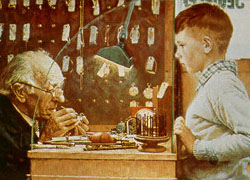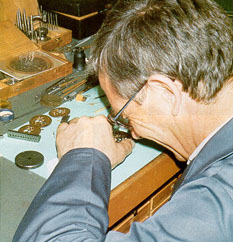 Is Time Running Out on the Watch Repair Business?
Is Time Running Out on the Watch Repair Business?
Reprinted from Modern Jeweler
By Norma Buchanan
 | | Norman Rockwell's mid-century vision of the venerable watchmaker is becoming an end-of-century reality. |
A generation of veteran watchmakers is getting ready to retire just as demand for its skills is on an uptick.
The bulletin board at The Texas Institute of Jewelry Technology at Paris Junior College is papered with help-wanted notices for full-time watch repairers, most posted by jewelers, many of them in faraway states. These jewelers are hoping to snare a prospective graduate of the school�s 16-month horology course, one of the biggest and best-known in the country.
To Frank Poye, who became a student at the school 10 years ago and now teaches there, the bulletin board is a sign of a budding watch repair renaissance. What was considered a moribund trade a few years ago is snapping back to life, thanks in large part, Poye believes, to a surge in consumer interest in mechanical watches, new and old, complicated quartz chronos and technical sports watches.
Others, however, see the crowded bulletin board as a sign of a looming problem. That�s because the school, located in Paris, Texas, has just 30 watchmaking students. �We don�t graduate anywhere near enough people to meet the demand for them,� Poye says. And what�s true at Paris Junior College is a trend all over the country.
 Over the past decade, the number of full-time watchmakers in the United States has fallen by several thousand to just 9,000 or 10,000 today, according to the American Watchmakers� Institute. During that time the number of watchmaking schools has also taken a nosedive- from 35 or so to a mere 22 today- and few of these survivors have more than 25 students. Over the past decade, the number of full-time watchmakers in the United States has fallen by several thousand to just 9,000 or 10,000 today, according to the American Watchmakers� Institute. During that time the number of watchmaking schools has also taken a nosedive- from 35 or so to a mere 22 today- and few of these survivors have more than 25 students.
As a result, the popular image of the watchmaker as a gray-haired old man stooped over his workbench is becoming more a reality than a mere bit of Norman Rockwell Americana. The average age of watch repairers is now between 50 and 60. That means repairers will be retiring at even-faster rates over the next few years.
Likely to feel the pinch first are jewelers with their own watch repair departments. Some are already complaining that they can spend months looking for people skilled enough to work on expensive complicated watches, despite offering salaries that can go as high as $60,000 plus benefits.
That problem may be getting worse. Although the long-term trend among retailers has been away from hiring their own watchmakers, some carriage trade jewelers are bucking that trend by starting up their own repair departments. They find it�s one way to offer the personal service that sets them apart from their competitors. �Among fine independent stores with a focus on service, more people are considering hiring their own watch repairers,� says Johann Jorgo, technical director at Baume & Mercier in New York. With more of these jewelers bidding for skilled watchmakers, the shortage could become acute.
Watch companies are also likely to suffer. Many already depend on watchmakers trained in Switzerland for the top spots in their service departments because this country lacks enough highly skilled people.
�There is a preoccupation with the problem in the industry,� says Partick Puton, who oversees the after-sales service department at Rolex Watch USA. Because of his brand�s lofty status in the watch world, it has not yet been affected by the shortage, he says, but concedes that one day it might be. �We haven�t seen a crisis yet at Rolex, but that doesn�t mean it couldn�t happen in the future,� he says.
One factor that could make the crunch even worse, some say, is that the newly popular mechanicals and complicated quartz watches have not yet started to hit the repair shops in large numbers.
�There is a whole generation of watches that haven�t needed major repairs yet,� says Mark Udell, owner of London Jewelers, with three stores on Long Island. Udell employs four watchmakers, and considers his repair department a vital part of his stores niche as a service-oriented operation. �What will be the impact? Are there enough qualified people to fix these watches?� he asks. He and others in the industry have their doubts.
The lost generation
Then years ago such apprehension would have seemed ridiculous. Frank Poye recalls that people thought he was �kind of crazy� when, in 1982, he entered Paris Junior College to study watch repair. �They thought watches were just something to throw away,� he says.
They had a point. Worldwide production of digital watches surpassed that of mechanicals for the first time that year- 149 million units to 146 million. The age of tricky hairsprings and intricate escapements- of any moving parts, in fact- seemed to be winding down. The surge in popularity of cheap digital watches crystallized the widespread conviction- born with the appearance of quartz technology in the late 1960�s- that watchmakers would soon be obsolete.
It was this growing fear that pushed enrollment at watchmaking schools down so steadily after 1970. The dozens of schools that had been set up during and after World War II to teach veterans a trade- some of them with 100 or more students- dropped out of sight. The trend was spurred on by the move within the repair profession to more sophisticated repair machinery that increased each worker�s productivity. As a result, young people who might have taken up watch repair had they been born 20 years earlier were choosing other fields, especially the burgeoning electronics industry.
Throughout the quartz crisis events in Switzerland paralleled those here. The Swiss industry has always been the training ground for the watch repairers in the world, offering comprehensive four-year watchmaking courses as well as specialized training programs that teach students to fix just about any timepiece ever made. But the appearance of quartz and the threat from the powerful Japanese industry caused a dramatic reversal in Swiss attitudes toward watchmaking careers. According to Hans Reiter, a Swiss-trained watchmaker who finished his four-year course in 1964, watchmakers stopped encouraging their children to enter the repair business, ending a tradition that in many Swiss families was generations old.
Reiter, who now heads the watch repair department at Mayor�s in Miami, says the Swiss crisis has had repercussions for the US. market because so many of the country�s top craftsmen are Swiss. �Good watchmakers are extinct,� he says.
Or if not extinct, at least endangered. The years of decline has produced a yawning gap in the watch repair labor force between the soon-to-retire repairers with the years of experience needed to fix complicated watch and the green cadets who are beginning to trickle back into the trade. And the lost generation couldn�t have picked a worse time to disappear.
What�s a hairspring?
That�s because the hottest watches on the market today are also the most difficult to maintain and repair. Mechanical watches, which in 1990 accounted for 22% of the value of worldwide watch production (and, in 1991, 44% of the value of Swiss watch exports) make demands on the repair trade which many say it is just not geared up to meet.
To start with, they need to be cleaned every two to three years, something that can only be done by a trained watchmaker. More extensive repairs, of course, require more time from more highly trained watchmakers. A complete overhaul of a mechanical, a Rolex, for example, can take 4 man-hours. Some high-end Swiss mechanicals can�t even be fixed in this country, and must be sent to Switzerland, where repairs may take months or, if the piece is extremely rare, years.
Mechanicals aren�t the only repair headaches. Quartz watches are still far from being the maintenance-free dreams the industry once thought they would become. Even simple quartz analog dress watches require routine lubrication to keep the mechanical part of the movement running smoothly.
Highly technical quartz watches can be a real nightmare for an inexperienced repair person. �Certain quartz watches involve computer technology," says Scott Chou, senior general manager in charge of the service department at Seiko Corp. in Mahwah, NJ. "Even changing the batteries in these watches can be tricky," he says. Many people entering the field don�t have the basic understanding of electronics needed to fix these watches, he maintains.
Apocalypse soon?
If the repair crisis isn�t averted, many observers think it will do irreparable damage to the watch business itself. One outcome will be that retailers unable to find qualified watchmakers will depend more heavily on manufacturers� after-sales service departments, which will themselves be hit by the skills shortage. Turnaround times, already too long to suit many consumers, will get even longer.
The public�s frustration will be all the more acute because these repair-intensive watches are so expensive. Customers who pay thousands of dollars for a watch think they�re entitled to speedy service, retailers point out. �They won�t wait six or eight to get a watch back,� says Tom Tivol of Tivol Jewels in Kansas City, Mo., who employs four watchmakers in his store.
Mark Udell says he must bear the brunt of the customer�s displeasure if a manufacturer takes too long with a watch he has sent back for repairs. �They take it out on us,� he says of his disgruntled repair customers.
Some fear consumers will become so frustrated that they swear off their expensive watches forever. The day may even come when consumers look back to the carefree days of the digital with the nostalgia they now feel for their father�s old wind-up watch.
A few watch companies and retailers are working to prevent that scenario by upgrading their service departments and improving their training programs. Rolex, for example, recently completed a renovation and expansion of its after-sales service department in New York, complete with high-tech video training equipment. A year ago, Mayor�s restructured its repair department by setting up a centralized repair department supplemented by on-site repairers in 15 of its 20 stores.
Other efforts are being made in the education area. A group of Swiss watch companies have given money and/or machinery to help with the renovation of the Joseph Bulova School for watchmaking in Woodside, Queens. The American Watchmakers Institute has started a new program called Project Extend, consisting of five-day courses on specialized areas of watchmaking, held at the AWI Education Center in Cincinnati.
Just as important as training, some say, is recruiting young people into the watchmaking trade. That will mean, in some cases, offering higher entry level salaries (which now start at $15,000 or $16,000) and, just as importantly, getting the word out that there are opportunities in watchmaking that don�t exist elsewhere. As Scott Chou says, �If the industry is to continue as it is, we�ll have to get people interested in watch repair once again.�
|